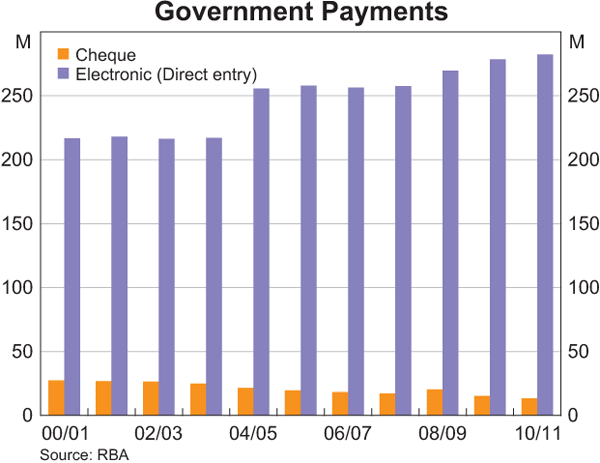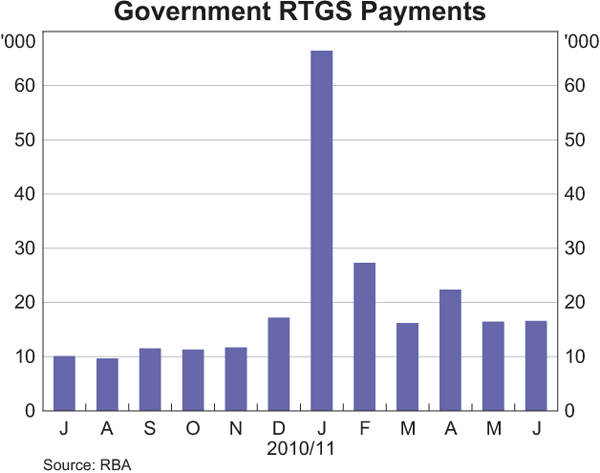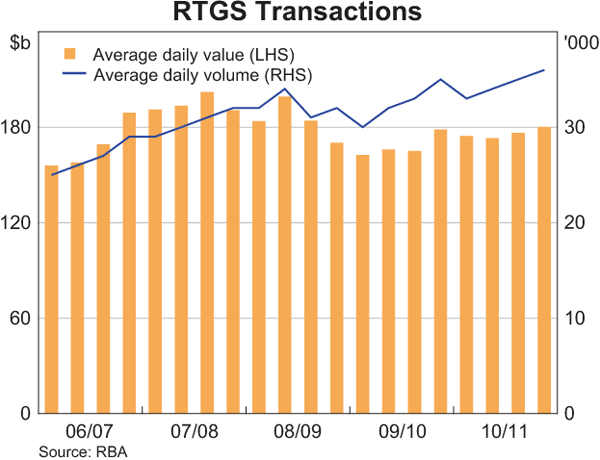Reserve Bank of Australia Annual Report – 2011 Banking and Payments
The Reserve Bank provides a range of banking, registry and payment settlement services to participants in the Australian financial system, the Australian Government, and other central banks and international bodies. These include services associated with the operation of the Australian Government's principal public accounts; transactional banking services to government agencies; custodial, registry and related services; and the operation of the real-time gross settlement (RTGS) system for high-value Australian dollar payments.
Banking
The Reserve Bank's banking services comprise two broad components: core and transactional banking services. Both are provided by the Reserve Bank's Banking Department with the common objective of delivering secure and efficient arrangements to meet the banking and payment needs of the Australian Government and its various agencies.
Core banking services are provided to the Department of Finance and Deregulation on behalf of the Australian Government, the Australian Office of Financial Management (AOFM) and a number of overseas central banks and other official institutions. These services derive directly from the Reserve Bank's role as Australia's central bank. Among other things, that role requires the Bank to manage the consolidation of all Australian Government Agency account balances – irrespective of which financial institution each agency banks with – into the Government's Official Public Accounts (OPA) at the Reserve Bank on a daily basis. This involves ‘sweeping’ each agency's balances from accounts with their transactional bank to the OPA at the end of the business day and back again the following morning. The Bank also provides the Government with a term-deposit facility for investment of its excess cash reserves, as well as a short-term overdraft facility to cater for occasions when there is unexpected demand on Commonwealth cash balances.
While the Reserve Bank manages the consolidation of the Government's accounts, the AOFM has day-to-day responsibility for ensuring there are sufficient cash balances in the OPA and for investing excess funds in approved investments, including term deposits with the Reserve Bank.
The Reserve Bank's transactional banking services involve the provision of more traditional banking and payment-related facilities. Principal among these is the delivery of direct entry payments from government agencies to recipients' accounts – some 282 million direct entry payments, totalling $291 billion, were delivered by the Reserve Bank in 2010/11. The Government also makes payments by cheque, though its use of cheques has fallen in recent years relative to electronic payment methods. Cheques now make up less than 5 per cent of agency payments. In addition to payments, the Bank provides its government agency customers with access to a number of bill collection services, including BPAY, over-the-counter, phone, internet and card-based payment facilities.
In contrast to core banking services, transactional banking services do not derive from the Reserve Bank's function as a central bank. They are, instead, provided on a commercial basis in line with the Australian Government's competitive neutrality guidelines. To deliver these services, the Bank must compete with other commercial financial institutions, in most instances bidding for business at tenders conducted by the agencies themselves. These agencies can require features that are common to government but not generally requested by other users of payment and collection services. Of particular importance are purpose-built overnight reporting and a demonstrated capacity to react quickly when changes in government policy require consequent alterations to the payments and collection processes of individual agencies. Because of its particular focus on the government sector, the Bank is well placed to respond to these specific requirements and tailor its systems accordingly. Some 90 government agencies are customers of the Bank's transactional banking services.

In recent years the Reserve Bank has worked closely with its government customers to ensure that their choice of payment and collection options is consistent with their needs, particularly for faster funds availability. In 2009, for example, the Reserve Bank introduced a service that allows agencies to use their own business systems to send urgent payments via RTGS throughout the day. The service was used extensively in early 2011 to make urgent relief payments to many victims of the floods and other disasters which affected various parts of Australia. Some 67,000 assistance payments were made via RTGS at the peak of the flood crisis in Queensland in January. Payments through this system had averaged around 13,000 per month up until that time.

During the year, the Reserve Bank also continued to work closely with other payments industry participants to improve important elements of the payments communication infrastructure, changes that will benefit all users, including the Bank's government clients. During the course of 2010/11, the exchange of direct entry and other low-value payments files between major payment services providers was successfully migrated to the Community of Interest Network (COIN) and away from a complex series of bilateral communication links. Work also started with industry participants to improve arrangements for settling low-value payments, known as the Low Value Settlement Service (LVSS). Additional information on this work is provided in the ‘Settlement Services’ section of this chapter.
In common with other financial institutions, the Reserve Bank has commenced a program of investment in its banking systems so that these will continue to provide customers with the highest levels of service and efficiency. The first stage of the program began in late 2010 and involves an upgrade of its online banking services – RBAnet and ReserveLink – combining them into one platform and offering access to a broader range of banking services. This stage of the program is expected to be completed in mid 2012.
After-tax earnings from the Reserve Bank's transactional banking services were $4.8 million in 2010/11, compared with $3.8 million in the previous year.
Registry
The Reserve Bank provides registry services to the Australian Government and a number of foreign official institutions that have Australian dollar debt programs. The services include registration of new debt issues, ongoing maintenance of ownership records, distribution of interest payments and redemption of securities at maturity. Those provided to the Australian Government cover issues of Commonwealth Government securities (CGS) and are undertaken under agreement with the AOFM.
The Reserve Bank also provides a small-investor facility that enables retail investors to buy and sell CGS. Increased interest from overseas investors, associated with the strength in the Australian dollar, saw the number of transactions through the facility rise slightly over 2010/11. Overall, though, the level of transaction activity remains quite low.
The Australian Government announced in December that it intends to allow retail investors to trade CGS on a suitable exchange. The announcement was part of a package of measures to improve competition in the Australian banking system. As exchange trading of CGS will impact on the functions of the registry, the Reserve Bank and the AOFM are reviewing the arrangements under which registry services are provided to the Government. The Bank has operated the registry for CGS for almost 40 years.
Earnings after tax for the CGS registry business were $0.2 million in 2010/11, similar to earnings in the previous year.
Settlement Services
The Reserve Bank owns and operates the Reserve Bank Information and Transfer System (RITS), which provides a real-time payments and settlement service for institutions that have been approved by the Bank to operate an Exchange Settlement Account (ESA). As at end June 2011, there were 58 such approved institutions; 10 other institutions hold an ESA but have appointed another ESA holder to act as a settlement agent in RITS. A further 28 institutions were Non-Transaction Members of RITS for the purpose of either being a Batch Administrator or to participate in the Bank's domestic open market operations.
Payments between institutions are settled in RITS across their respective ESAs. By value, about 90 per cent of all payments settled in RITS are settled individually on an RTGS basis. These include time-critical customer payments, all wholesale debt and money market transactions and the Australian dollar legs of foreign exchange transactions. The latter includes Australian dollar trades involved in continuous linked settlement (CLS), for which net amounts are paid to and received from CLS Bank each day.

In addition to RTGS payments, RITS settles batches of netted payments. One batch is a dedicated multilateral settlement at 9.00 am each day for payments arising from cheque, direct entry and retail card transactions that are cleared through low-value systems prior to settlement the next business morning across RITS. A batch settlement facility in RITS also allows approved Batch Administrators to submit batches of netted payments to RITS at any time during the business day. This facility is used once each day by the Australian Securities Exchange for settlement of payments arising from equity transactions.
After falling in the previous two years, the average daily value of RTGS transactions in 2010/11 grew by 4.8 per cent, to $176 billion. Even so, values settled were still about 10 per cent less than in 2007/08, before the depth of the global financial crisis. By contrast, the number of transactions settled has recovered strongly, and averaged 34,300 on a daily basis during 2010/11. A new daily transaction record was set on 27 April, when 59,846 transactions were settled.
The Reserve Bank devotes significant operational resources and undertakes an ongoing program of capital investment to ensure that RITS operates to the extremely high standards of availability and resilience appropriate to its critical importance to the Australian financial system. As part of the RITS capital maintenance program, the infrastructure supporting the RITS user interface was replaced during 2010/11. Work also commenced to replace the SWIFT infrastructure which supports RITS and the Bank's own high-value payment transactions and that of its official customers.
Last year's annual report described the RITS Low Value Feeder (LVF) project, aimed at introducing new infrastructure for low-value payments. The key components of this work are the provision of the RITS Low Value Clearing Service and Low Value Settlement Service (LVCS and LVSS). The LVCS connects the Reserve Bank to all institutions directly involved in payments clearing using SWIFT and the industry COIN. This enables RITS Members to choose either network to exchange clearing files (for example, in respect of the direct entry system used for payments such as payroll credits) with institutions that have chosen to use the other network. It commenced operations in June 2010. Currently 10 institutions use the LVCS to exchange files for 14 RITS Members.
The LVSS builds on the LVCS infrastructure to provide enhanced functionality in three ways. It will:
- enable RITS Members to provide file settlement instructions to RITS, for low-value clearings, by either SWIFT or the COIN, at around the same time as clearing activity takes place between institutions; currently, the settlement instructions for all clearing information exchanged during the day are aggregated and sent to the Reserve Bank on the evening of exchange, prior to settlement across RITS at 9.00 am on the next business day;
- upgrade instructions to a modern message format using the global ISO 20022 messaging standards framework, replacing formats introduced in 1993; and
- allow greater flexibility in the settlement of these instructions by RITS, either at 9.00 am as now, or at intervals during the day of exchange
In April 2011, the Reserve Bank implemented the initial changes to RITS to enable submission and settlement of file settlement instructions. Changes specifically required for 9.00 am Settlement (such as calculation of clearing interest) are targeted to be complete in the fourth quarter of 2011. It is expected that RITS Members who participate in the 9.00 am Settlement will have completed development and testing of the new LVSS settlement instructions with the Reserve Bank in the first quarter of 2012, with the new arrangements becoming fully operational later that year.
As noted earlier, the LVSS infrastructure will also support future migration to allow settlement as clearing files are exchanged, rather than on the next day as occurs at present. This reduction of the gap between clearing and settlement will reduce risk and may assist in faster access to funds, particularly when larger value payments are made using the direct entry system. The industry is currently exploring the benefits of such ‘same-day settlement’.
The Reserve Bank also provides settlement services for banknote lodgements and withdrawals by commercial banks and for RTGS settlement of (mainly high-value) transactions undertaken by the Bank and its customers, including the Australian Government, overseas central banks and official institutions. In addition, the Bank has used RTGS settlement to provide Centrelink emergency benefit payments where funds were urgently required. As noted earlier, this service was used heavily during the flood crisis in January.
The number of central banks holding accounts at the Reserve Bank increased from 46 to 49 over the year. The Bank provides these institutions with settlement and safe custody services to settle their Australian dollar transactions. Reflecting increased overseas demand for Australian dollar investments, the amount held in custody by the Bank for these institutions increased by $11.1 billion to $40.9 billion over the year.